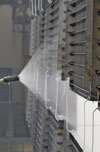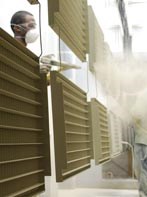Closed-Loop Cleaning/Pretreatment
System fits with 'keep it simple' powder coating philosophy
#racking
Ohio Gratings Inc. (OGI; Canton, OH) began life in 1970 as a supplier of light-duty steel bar gratings for flooring and other applications. The company has since expanded into manufacturing of heavy-duty welded, press-fit and swaged gratings in a variety of materials including steel, stainless steel, galvanized and galvanneal steel, and aluminum alloys. Gratings are supplied in a number of finishes, from bare to dip coated and, more recently, powder coated.
Applications for the company's products have similarly grown to include decking for process plants such as water treatment facilities, bridge decking and flooring for sports facilities. OGI currently operates out of a 300,000 ft2 facility with 290 employees, and one of the company's current initiatives is to branch out further into manufacture of architectural products such as grilles, screens, louvers, fencing and sunshades.
Featured Content
In-House Powder
OGI has always focused on on-time delivery of quality products to its customers, but the relatively new emphasis on products for architectural applications places even more importance on quality and process control, according to finishing line manager Ty Hilbert.
To offer customers a more durable finish on products destined for architectural and other demanding applications, Ohio Gratings has recently added in-house powder coating to its finishing capabilities, and Hilbert, with years of experience setting up and operating powder lines for automotive and other applications, was the man brought in to get the line up and running.
"Until we started this line, all of our powder coating was outsourced," he explains. "The company did a lot of dip coating in house, and still does. But dip coating really is an inferior finish compared with powder, and the cost of outside powder coating, plus the ability to better control quality to meet architectural specifications, were the main reasons the company decided to bring powder coating in house."
Hilbert has been involved in every aspect of implementing the powder coating system, from line design to purchasing, installation, hiring and training of operators and launching. Both he and OGI like to "fly under the radar," as Hilbert puts it, and the powder line design reflects that.
"I've been involved in operating some powder systems that were so elaborate they were hard to control," Hilbert says. When you lose control, that's when the product comes out bad. So simpler is better in my book."
The "keep it simple" approach includes a relatively short conveyor; single-stage, manual spray wand cleaning/pretreatment system; one powder booth currently manned by two operators, and a small-footprint catalytic gas-infrared convection oven. Future plans call for use of reciprocators for powder application and a new, five-stage washer/pretreatment system for aluminum products, but right now OGI is still working out a few kinks in its current system and getting finishing line personnel up to speed.
"Most of the coating we're doing right now is pretty simple, with 2–3 mils of cured film thickness," Hilbert explains. "We check coating thickness using an ultrasonic or eddy-current gage depending on the substrate material, and we also do some standard testing for cure and adhesion—MEK rubs, scratch tests, things like that.
"But the architectural stuff will be a little different," he continues. "Eventually we want to be certified to [American Architectural Manufacturers Association] AAMA 2604, which is a pretty demanding standard for aluminum architectural pieces. It's a lot like ISO 9001; you need to set up and document all your quality systems and perform tests according to the specification."
One thing that won't change much even when more architectural products are in the mix is the powder material. OGI is currently spraying almost exclusively polyesters, and Hilbert expects that to continue regardless of substrate material. "Just about everything we make goes outside, and for outdoor exposure polyester is the best. It's super-durable," he explains. "Some specialty products for laboratory or other indoor use may get epoxy, but the vast majority of our products will have a polyester coating material."
OGI currently sprays three standard colors and has the capability to spray custom colors as well. With reclaim on the primary colors, Hilbert says overall transfer efficiency is 90–95%. The powder line currently runs only a single shift, but that could change as in-house dip coating is phased out.
Although compact, the line can handle parts up to 24 ft long and 6 ft deep, and the conveyor currently runs at speeds of 2.5–3.5 fpm. "Our parts don't require complicated racking, and we work to maximize line density, not speed," Hilbert explains.
After manual powder application, parts cure in a 30-ft catalytic gas infrared convection oven featuring 18, 72,000-Btu emitters. "It's a very quick cure," Hilbert says. In a normal convection oven, you have to bring the entire part to temperature and then start the curing process. We basically cure from the outside in, so we get a complete cure in about 8–10 min on some pretty thick products."
Like other aspects of the line, the oven is a modular design that can be easily expanded to handle increasing part volumes. It's also very energy efficient, according to Hilbert. "We had our natural gas supplier in here to check it out, and gas consumption is about one-half or less of a normal convection oven," he says.
Dealing with Galvanized
Although most architectural pieces will be fabricated from 6000-series aluminum alloys, OGI still processes tons of galvanized steel gratings, according to Hilbert. "The galvanizing is done outside—we have no desire to be a plating shop," he says. "But a lot of customers are looking for what they call a duplex finish, which is paint or powder over galvanized, so we still deal with a lot of galvanized substrates.
"The problem with galvanized steel is handling zinc metal that will contaminate our waste water," he continues. To eliminate zinc metal contamination and related wastewater treatment problems, OGI chose to implement a closed-loop cleaning and pretreatment system supplied by Evco Industrial (Chagrin Falls, OH).
Designed for paint and powder operations, the skid-mounted ChemCapture closed-loop cleaning and pretreatment system consists of a tank that holds the chemical wash/phosphate solution, a high-pressure washer system, a solution return system and an evaporator.
At OGI, the cleaning/pretreatment tank holds an iron phosphate chemistry that contains a surfactant to aid cleaning, but the high-temperature, 300-gal plastic pretreatment tank can accommodate a range of chemistries and process temperatures and provides control of chemistry temperature and composition from the tank. This system is said to be superior to downstream chemistry injection, which is common with most wash reclaim systems. The heated tank also prevents growth of bacteria and algae.
OGI controls pretreatment chemistry with titrations twice per shift. "We've already got our chemical consumption and additions figured out pretty well," Hilbert says. "If you're consistent in your testing and addition schedule, you can pretty much smooth out any peaks and valleys. That's what we try to do."
Integrated directly into the system and powered by the main control panel, the system's high-pressure washer is rated at pressure to 2,400 psi, flows to 4.5 gpm and temperatures to 190ºF. Operators can easily regulate pressure during operation, and simple disconnect nozzles offer various spray patterns and pressures. The operator switches between iron phosphate and RO rinse by flipping a switch.
Solution is recirculated though the system at 45 gpm by a Type 316 stainless steel pump outfitted with a custom control system that automatically turns on/off when the wand trigger is off and the washer is in bypass mode for a short period of time. This is said to eliminate wear and tear on the pump and motor and preventing solution from heating in the bypass line when the wand is shut off.
The recirculation loop passes through a heavy-duty, 36-inch stainless steel filter vessel containing a polypropylene bag filter housing with 200-µm nylon bag to filter large particles before returning solution. Solution travels through a heat exchanger, circulates back to the tank and is injected along the bottom to control the amount of contaminants in suspension.
The system uses only ambient-temperature RO water for rinsing, the idea being that properly cleaned parts require only minimal amounts of rinse water. Contaminated rinse water is removed from the system by automatic evaporation in a high-temperature plastic tank.
The same heat exchanger used to heat recycled cleaning solution is used for evaporation. This allows fresh rinse water to be continuously brought into the system. Atmospheric evaporation does not require heating the solution to boiling and therefore uses less energy than conventional evaporators.
The design also eliminates heat plates in the system where chemistry can collect or fuse on the heat exchanger. Instead, contaminated rinse water is circulated through the same low-temperature heat exchanger as used to heat the wash tank and sprayed out in a mist that cascades over the evaporation media. Air is blown through the mist at 2,000 cfm and "cools" the solution, which causes evaporation at a rate of approximately 25 gal/hr.
The ChemCapture system was designed primarily for batch-type operation, so continuous operation at OGI is a bit of a departure from the "standard" system application. Despite this, Hilbert says the closed-loop system has worked well and is definitely in keeping with his "keep it simple" philosophy.
RELATED CONTENT
-
Masking for Surface Finishing
Masking is employed in most any metal finishing operation where only a specifically defined area of the surface of a part must be exposed to a process. Conversely, masking may be employed on a surface where treatment is either not required or must be avoided. This article covers the many aspects of masking for metal finishing, including applications, methods and the various types of masking employed.
-
Removing Cured Powder Coatings
Question: What methods are available for removing cured powder coatings, and what are the pros and cons of these methods?
-
Proper Testing of a Powder Coat Finish
Manufacturer shows how it performs extensive tests on powder coated medical carts.





















